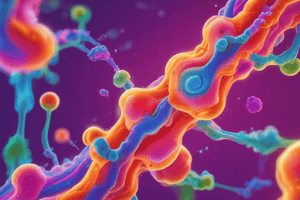Podcast
Questions and Answers
What is the primary role of circulating hormones within the body?
What is the primary role of circulating hormones within the body?
- To directly build new cellular structures.
- To provide immediate energy for muscle contractions.
- To act as a structural component of cell membranes.
- To control the rates of body processes and maintain homeostasis. (correct)
Where do endocrine cells secrete hormones?
Where do endocrine cells secrete hormones?
- Directly into the bloodstream via arteries.
- Into nearby capillaries. (correct)
- Through ducts leading to specific target organs.
- Into the interstitial fluid surrounding the cells.
What determines whether a cell is a target cell for a specific hormone?
What determines whether a cell is a target cell for a specific hormone?
- The presence of specific receptors that bind to that hormone. (correct)
- The proximity of the cell to the endocrine gland.
- The metabolic rate of the cell.
- The blood type of the cell.
What happens to a cell that lacks the specific receptor for a hormone, even when the hormone is present?
What happens to a cell that lacks the specific receptor for a hormone, even when the hormone is present?
Why do water-soluble hormones typically bind to receptors embedded in the plasma membrane of target cells?
Why do water-soluble hormones typically bind to receptors embedded in the plasma membrane of target cells?
How does the binding of a water-soluble hormone to its receptor lead to the activation of intracellular G proteins?
How does the binding of a water-soluble hormone to its receptor lead to the activation of intracellular G proteins?
What molecular exchange occurs when a G protein is activated?
What molecular exchange occurs when a G protein is activated?
What enzyme does an activated G protein bind to, and subsequently activate?
What enzyme does an activated G protein bind to, and subsequently activate?
What is produced when adenylate cyclase is activated?
What is produced when adenylate cyclase is activated?
What is the role of cyclic AMP in the signaling pathway of water-soluble hormones?
What is the role of cyclic AMP in the signaling pathway of water-soluble hormones?
How do activated protein kinases affect the activity of other proteins within the cell?
How do activated protein kinases affect the activity of other proteins within the cell?
What determines the specific hormone response of a cell?
What determines the specific hormone response of a cell?
How is cyclic AMP production terminated once the hormone signal needs to be stopped?
How is cyclic AMP production terminated once the hormone signal needs to be stopped?
What is the role of phosphodiesterase in regulating the cell's response to a hormone?
What is the role of phosphodiesterase in regulating the cell's response to a hormone?
How do G proteins return to their inactive state?
How do G proteins return to their inactive state?
What change occurs in protein kinase when cyclic AMP concentration returns to resting levels?
What change occurs in protein kinase when cyclic AMP concentration returns to resting levels?
Which of the following statements best describes the amplification of a hormone signal in a target cell?
Which of the following statements best describes the amplification of a hormone signal in a target cell?
What is the ultimate outcome of the response of many target cells to hormone signals?
What is the ultimate outcome of the response of many target cells to hormone signals?
In the context of endocrine signaling, what would happen if phosphodiesterase were inhibited?
In the context of endocrine signaling, what would happen if phosphodiesterase were inhibited?
A scientist discovers a new drug that prevents G proteins from releasing GDP. What effect would this drug have on endocrine signaling?
A scientist discovers a new drug that prevents G proteins from releasing GDP. What effect would this drug have on endocrine signaling?
Flashcards
Endocrine System
Endocrine System
Tissues throughout the body that produce hormones.
Hormones
Hormones
Chemicals secreted by endocrine cells that travel through the bloodstream to target cells, controlling the rates of body processes and maintaining homeostasis.
Target Cells
Target Cells
Cells that have specific receptors to bind to a particular hormone, triggering a response.
Hormone Receptors
Hormone Receptors
Signup and view all the flashcards
Water-Soluble Hormone Receptors
Water-Soluble Hormone Receptors
Signup and view all the flashcards
Second Messenger
Second Messenger
Signup and view all the flashcards
Cyclic AMP (cAMP)
Cyclic AMP (cAMP)
Signup and view all the flashcards
Protein Kinases
Protein Kinases
Signup and view all the flashcards
Phosphodiesterase
Phosphodiesterase
Signup and view all the flashcards
G Protein
G Protein
Signup and view all the flashcards
Adenylate Cyclase
Adenylate Cyclase
Signup and view all the flashcards
Signal Amplification
Signal Amplification
Signup and view all the flashcards
Phosphorylation
Phosphorylation
Signup and view all the flashcards
Homeostasis
Homeostasis
Signup and view all the flashcards
Study Notes
- The endocrine system consists of hormone-producing tissues throughout the body.
- Circulating hormones control body processes and maintain homeostasis.
- Endocrine cells within endocrine glands secrete hormones that diffuse into nearby capillaries.
- The cardiovascular system transports hormones, affecting target cells in various tissues.
- Target cells have receptors that bind to specific hormone shapes.
- Cells lacking the specific hormone receptor are unresponsive, regardless of hormone concentration.
- Water-soluble hormones bind to receptors on the cell's plasma membrane because they cannot enter the cell directly.
- Water-soluble hormones exert effects through the intracellular second messenger cyclic AMP.
Hormone-Receptor Binding
- A hormone molecule, the first messenger, binds to its receptor, causing the receptor to change shape.
- The activated receptor activates intracellular G proteins by releasing a GDP molecule and exchanging it for a GTP molecule.
- The G protein changes shape and becomes active.
Amplification Process
- A hormone-bound receptor activates many G proteins, amplifying the signal from a single hormone molecule.
- Activated G proteins bind to and activate adenylate cyclase.
- Adenylate cyclase converts ATP to cyclic AMP, the second messenger.
- Many cyclic AMP molecules are produced from each activated cyclase enzyme, further amplifying the hormone signal.
Cellular Response
- Increased cyclic AMP activates protein kinases.
- Activated protein kinases phosphorylate various proteins within the cell, changing their activity.
- The cell's hormone response is generated based on the proteins present in the cytoplasm that can be phosphorylated by protein kinase.
Signal Termination
- The cellular response diminishes when the hormone is no longer bound to its receptor.
- G proteins hydrolyze GTP to GDP, returning to their inactive state and dissociating from adenylate cyclase, ending cyclic AMP production.
- Phosphodiesterase degrades existing cyclic AMP.
- As cyclic AMP concentration returns to resting levels, protein kinase inactivates, preventing further protein phosphorylation.
- The target cell returns to its pre-stimulus condition, ready for future hormone signals.
Summary
- A water-soluble hormone binds to a receptor on the plasma membrane.
- The signal is amplified through G proteins and cyclic AMP generation.
- Cyclic AMP activates protein kinases, affecting intracellular proteins and shaping the target cell's response.
- The response of many target cells produces the homeostatic and regulatory effects controlled by the endocrine system.
Studying That Suits You
Use AI to generate personalized quizzes and flashcards to suit your learning preferences.




